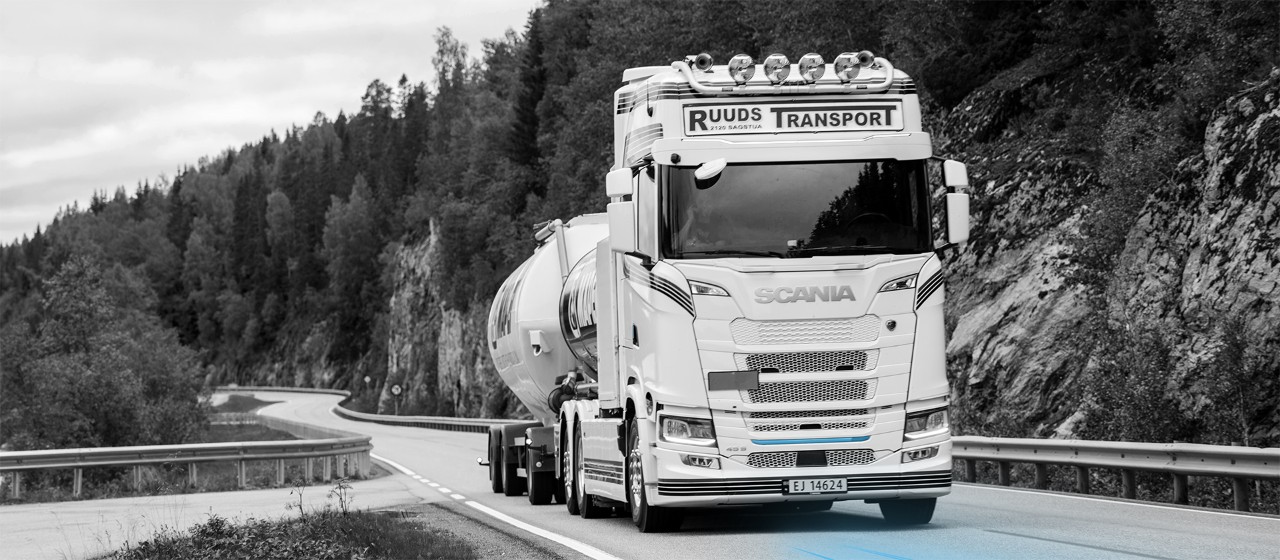
Record-long trip with electric truck “exceeded all expectations”
Norwegian transport company Ruuds wanted to test their new battery-electric Scania on a real long-distance trip, taking a 47.5-tonne truck and trailer combination on an 1,830-kilometre journey. The results exceeded all expectations.
Knut Ruud, CEO of Ruuds Transport in Norway, recently embarked on a groundbreaking journey with his son Simen to explore the limits of electric transport. Not only did they aim to test the company’s first of several soon-to-be-delivered Scania battery-electric vehicles (BEVs), they were also keen to see how charging would work on a long-distance trip. In this case a trip from south-east Norway to the far north of the mountainous country, a distance of 1,830 kilometres.
“The trip exceeded all expectations. The truck performed exactly as expected, and the range aligned with the analyses we received beforehand,” says Ruud. Despite anticipating some challenges, they encountered no issues that couldn’t be resolved on the spot.
Satisfied drivers: Knut Ruud with his son Simen en route.
Demonstrates longer trips with battery-electric trucks are feasible
The BEV truck used for the trip is Scania’s largest and newest battery-electric model to date. Designed for regional transport up to 300 kilometres, it typically starts and ends its journeys at a depot. However, Ruuds Transport’s test demonstrates that significantly longer trips are feasible.
The configuration for the Scania 45 S 6x2*4 truck included a mounted chemical tanker and a three-axle bulk trailer. With a total gross train weight of 47.5 tonnes, the truck and trailer combination required charging stops approximately every 200 kilometres.
From south to north: 1,830 kilometres. Ruuds Transport tested its new battery-electric Scania on an exceptionally long trip, delivering chemicals and cement for the company’s client Mapei.
Accessing chargers for passenger cars
Knut Ruud’s idea of undertaking a long-distance journey that was unprecedented for a battery-electric truck required substantial planning. Together with Scania Norway, Ruud meticulously analysed the trip in advance using Scania’s analysis tool, which considers factors such as vehicle weight, road conditions, and the topography of the journey. Based on this analysis, a route was created that included planned charging stops.
As they passed through sparsely populated regions in Norway, Ruud and his son had to rely primarily on chargers designed for passenger cars. Despite this, they encountered no issues in physically accessing any of these chargers with their truck.
“However, there were significant differences between the various chargers,” Ruud says.
The biggest challenge was access to chargers. At this charging point, everything went smoothly, even though it was built for use by passenger cars.
Increasing focus on emission-free supply chains
Ruuds Transport is a family-owned company specialising in transport for the construction industry, a sector with an increasing focus on climate concerns. This was a key motivation for Knut Ruud to arrange the test, as well as for Ruuds Transport’s client Mapei, a world-leading manufacturer of chemical products, who also participated in the trial.
“In the construction industry, there is growing emphasis on ensuring the supply chain is as emission-free as possible,” says Ruud. “Climate reduction is also a high priority for our client Mapei.”
Knut Ruud adds that Ruuds Transport has gained valuable insights from the record-long drive. “One of the most important lessons is that we can utilise this truck far more extensively than we initially thought.”
Read more

Charging
We help you find the right charging solution for your specific need.
